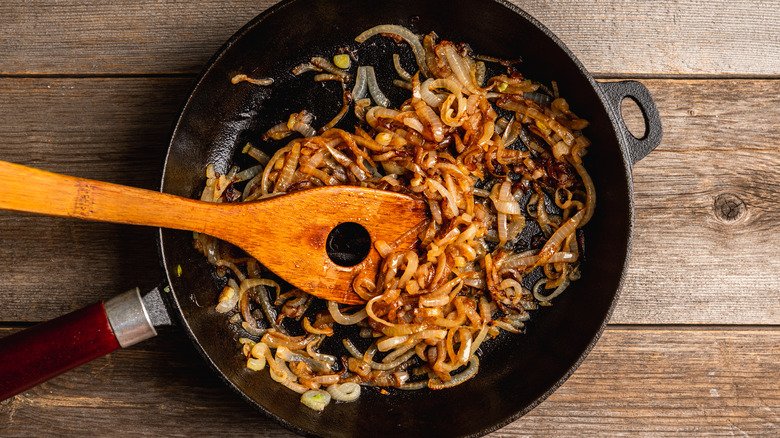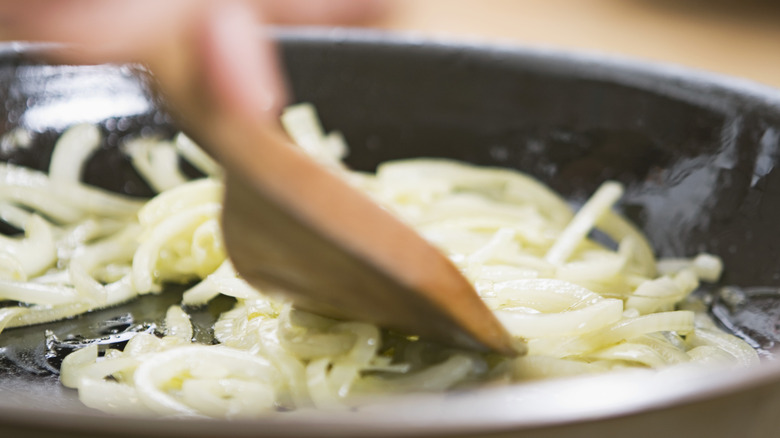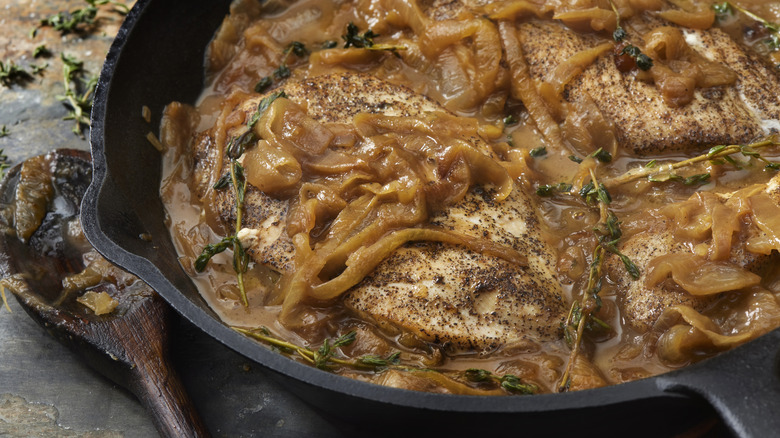The Key To Perfectly Caramelized Onions Is Patience (And Then More Patience)
If your approach to making caramelized onions involves stirring them around in sizzling oil until the edges start to brown, unfortunately, you haven't been doing it right. While this process does introduce color and flavor to your onions, it technically isn't caramelization, but rather browning, an entirely different cooking technique.
Caramelization occurs when the natural sugars in an ingredient turn into a caramel. This gradual process happens when the moisture and sugar get released and eventually cook down, ultimately producing a rich sweet flavor and an even brownness that isn't just limited to the edges.
Browning, on the other hand, is the result of the Maillard reaction. It occurs a lot faster, whenever the sugar, proteins, and enzymes of a food react with one another in the presence of heat. Browning does deepen the flavor of onions, but it cannot yield the same level of sweetness that results from caramelization. If you want your onions to actually caramelize instead of just browning, you'll need to exercise a little patience.
Properly caramelizing onions takes time
Caramelizing onions isn't a complicated cooking technique but it does require time to properly execute. Not only does the internal temperature have to climb to 230 degrees Fahrenheit, but the water has to fully release from within the onion, and the sugars need enough time to caramelize. This can only occur when the heat is kept low because otherwise, the onions will burn before caramelization has been achieved.
Caramelization will therefore take at least 40 minutes or even a whole hour, so if you see signs of browning long before then, chances are the heat is too high and the browning you're seeing is due to the Maillard reaction instead. Just keep in mind that even if you keep the heat low, it's still possible to over-caramelize onions. If you let the color of the onions go past the point of dark brown, they'll start to get mushy and the sweetness will turn to bitterness.
Is there a faster way to caramelize onions?
Before onions can caramelize, they have to wilt first. Though caramelization itself can't be sped up, the wilting can. To do so, you simply add extra water to your pan, cover it, and increase the heat so it can steam. Just make sure to lower the heat after the onions have wilted so caramelization can follow.
Baking soda can also help expedite things. While it does not directly affect caramelization, it does increase the pH of your onions. This in turn breaks down the pectin in the onion, which in turn speeds up the overall cooking process. The National Onion Association found that this baking trick allowed them to get caramelized onions in about 15 minutes. However, there are a few caveats; this trick results in a much mushier texture so is only useful in certain recipes and, if you add too much baking soda, it can cause your onions to have a metallic baking soda taste.
These hacks can certainly shave off a bit of time, but in general, we think it's worth letting caramelization naturally play out. Onions don't really need much babysitting anyway, as they're cooked low and slow. For caramelized onions that get the time they deserve but don't require your constant attention, we'd recommend sticking them in a slow cooker and walking away. After all, caramelization is just sugar plus time.


